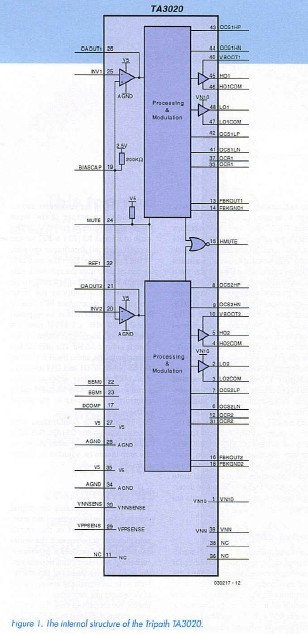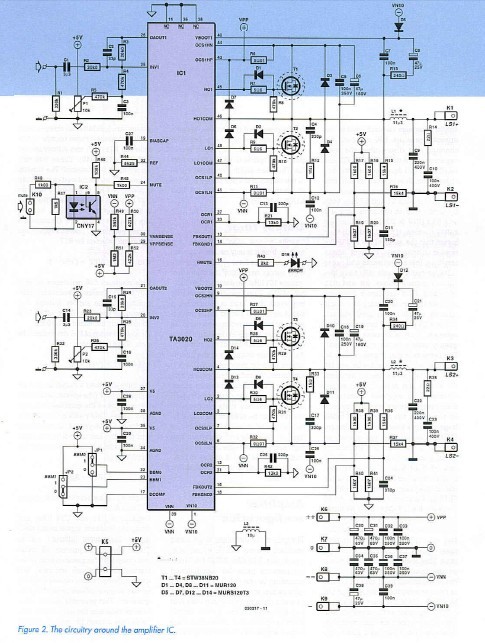

Project Solutions
Clarity 2x300W: Class-T amplifier (1)
Published:2011/8/3 1:38:00 Author:Li xiao na From:SeekIC
By Ton Giesberts
This top-end amplifier proves that high power does not have to mean a large, heavy design. Although this amplifier is highly efficient (and thus compact), its specifications easily surpass those of quite a few conventional designs.
If we’ve given you the idea that the fully assembled amplifier is as light as a feather, perhaps we should qualify our statement somewhat. After all, 2 x 300 watts of true power naturally requires a rather substantial power supply. But that’s the only aspect of this amplifier that is comparable to other types of amplifiers. Thanks to clever use of pulse-width modulation, this amplifier is so efficient that a heat sink with quite modest dimensions can be used, which means that the enclosure can also be kept relatively small. What’s more, this amplifier is not an ordinary pulse-width amplifier. This design, which is based on the Tripath TA3020 Class-T digital audio driver, has excellent specifications and can easily hold its own against other top-end amplifiers. For more information about pulse-width modulation in audio final amplifiers, please see the article ’That’s class...’ elsewhere in this issue. The design is largely based on the standard application example and the manufacturer’s reference PCB layout. This is because the board layout largely determines the quality of the overall amplifier. Besides this, the nature of this design (with high switching frequencies and large currents) imposes severe requirements on various components. That means that special types of electrolytic capacitors and decoupling capacitors are used in most locations. Even for the thermal coupling between the output transistors and the heat sink, ordinary mica or Kapton washers are not satisfactory.
Instead, ceramic washers with a thickness of several millimetres must be used. The IC also needs two auxiliary supply voltages, for which a separate printed circuit board has been developed. This board also includes a mains voltage switch-on delay for the main transformer and two hefty fuses for the main supply voltages. To suppress electromagnetic interference (EMC), extra filters are also included at the inputs and outputs. This should already give you an idea of what to expect, but in this first part of the article we primarily concentrate on how the Tripath IC works. 
In Figure 1, you can clearly see that the IC essentially consists of three sections for each channel: an analogue input stage (inverting amplifier), a processing and modulation unit, and the driver stages (level shifters) for the external power MOSFETs. The IC also provides overcurrent protection, over-voltage and undervoltage protection, and a connection for an external mute signal. All of these collectively determine whether the amplifier outputs are active.
Input stage 
The analogue input stage is implemented as an inverting amplifier for convenient dimensioning of the gain and bandwidth. According to the IC specifications, the maximum allowable signal level for fully driving the modulator is 4 Vpp. With the dimensioning used here, assuming an input sensitivity of 1.13 Veg for maximum output amplitude, the output of the input stage can be driven to 3.2 VDD. The ratio of R3 and R2 (R24 & R23~for the second channel) determines the gain of the input stage. Here the ratio is 1, as can be seen from the schematic diagram in Figure 2. Capacitor C2 (C15) increases the stability of the input amplifier and suppresses RF noise by limiting the bandwidth to approximately 240 kHz. CI (C14) sets the lower corner frequency, which in this case is around 2.5 Hz. The gain for frequencies in the audio band is thus as flat as possible. CI and C14 are standard MKT capacitors, since as a matter of principle we try to avoid using electrolytic capacitors in the signal path.
R4, R5 and PI, in combination with decoupling capacitor C3 (R25. R26. P2 & C16), allow the output offset voltage of the amplifier to be adjusted to a minimum.
Reprinted Url Of This Article: http://www.seekic.com/blog/project_solutions/2011/08/03/Clarity_2x300W__Class_T_amplifier_(1).html
Print this Page | Comments | Reading(2419)
Article Categories
New published articles
· Imagination works with TSMC to develop FinFET process
Author:Ecco Reading(45713)
· XMOS pushes event-driven MCUs with lower price
Author:Ecco Reading(4142)
· Intel brings upgraded 32-nm SoC for smartphones
Author:Ecco Reading(3865)
· Micron pushes TLC 128-Gbit NAND flash
Author:Ecco Reading(4612)
· Intel will stop supplying desktop motherboards
Author:Ecco Reading(5962)
· Processor market was expected to regain strength in 2013
Author:Ecco Reading(3957)
· It was reported that TSMC sales fall steeply
Author:Ecco Reading(3619)
· Cisco, NXP work with auto wireless startup
Author:Ecco Reading(4283)
· Micron was impacted by manufacturing glitch
Author:Ecco Reading(4647)
· China can make 22-nm transistor by themselves
Author:Ecco Reading(4486)
· Chip market rebound is coming, according to survey
Author:Ecco Reading(4387)
· Sony, Toshiba will spend more on chips, iSuppli reports
Author:Ecco Reading(3954)
· Qualcomm becomes the 13th company to join NFC Forum board
Author:Ecco Reading(6795)
· TSMC increases building work for FinFET fab
Author:Ecco Reading(4469)
· TI plans to cut 1,700 jobs in OMAP shift
Author:Ecco Reading(5327)